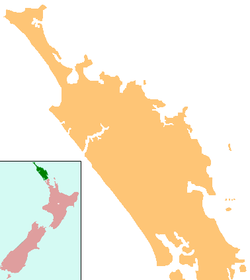Pukepoto
Pukepoto | |
|---|---|
 Pukepoto | |
| Coordinates: 35°9′25″S 173°13′24″E / 35.15694°S 173.22333°E | |
| Country | New Zealand |
| Region | Northland Region |
| District | Far North District |
| Population (2018) | |
| • Total | 162 |
Pukepoto is a town in Northland, New Zealand. It lies south west of Kaitaia and north east of Ahipara. The Herekino Forest lies to the south east.[1][2]
Pukepoto is a cobalt blue pigment which can be found in clay rock.[3]
Demographics[]
| Year | Pop. | ±% p.a. |
|---|---|---|
| 2006 | 1,041 | — |
| 2013 | 1,131 | +1.19% |
| 2018 | 1,134 | +0.05% |
| Source: [4] | ||
The population of the meshblocks immediately adjoining Pukepoto was 162 at the 2018 New Zealand census.[5]
Pukepoto is within the statistical area of Tangonge, which at 177 square kilometres is much larger than the locality, and includes the area between Kaitaia and Ahipara, extending north to Split Lake, south to the northern side of Herekino Harbour, and west to Tauroa Peninsula.
Tangonge had a population of 1,134 at the 2018 census, an increase of 3 people (0.3%) since the 2013 census, and an increase of 93 people (8.9%) since the 2006 census. There were 390 households. There were 573 males and 558 females, giving a sex ratio of 1.03 males per female. Of the total population, 252 people (22.2%) were aged up to 15 years, 174 (15.3%) were 15 to 29, 519 (45.8%) were 30 to 64, and 186 (16.4%) were 65 or older. Figures may not add up to the total due to rounding.
Ethnicities were 62.7% European/Pākehā, 59.5% Māori, 4.2% Pacific peoples, 1.1% Asian, and 2.1% other ethnicities. People may identify with more than one ethnicity.
The percentage of people born overseas was 6.9, compared with 27.1% nationally.
Although some people objected to giving their religion, 35.2% had no religion, 44.2% were Christian, and 13.5% had other religions.
Of those at least 15 years old, 108 (12.2%) people had a bachelor or higher degree, and 198 (22.4%) people had no formal qualifications. The median income was $26,700. The employment status of those at least 15 was that 411 (46.6%) people were employed full-time, 144 (16.3%) were part-time, and 42 (4.8%) were unemployed.[4]
Marae[]


Pukepoto has two marae connected with the iwi (tribe) of Te Rarawa, maunga (mountain) of Taumatamahoe and repo/wai (water/wetland) of Tāngonge. Descendants of these marae identify with the ancestors Tumoana (captain of the Tinana waka), Tarutaru (who consolidated iwi Te Rarawa to revenge the death of Te Ripo), and Ngamotu (the daughter of Tarutaru).[6]
Te Rarawa Marae and meeting house are affiliated with the hapū of Ngāti Te Ao and Te Uri o Hina.
Te Uri o Hina Marae and Hohourongo meeting house are affiliated with the hapū of Ngāti Te Ao, Tahāwai and Te Uri o Hina.[7][8]
In October 2020, the Government committed $1,407,731 from the Provincial Growth Fund to upgrade Te Rarawa Marae, Te Uri o Hina Marae, and 7 other marae of Te Rarawa, creating 100 jobs.[9]
Education[]
Pukepoto School is a contributing primary (years 1-6) school[10] with a roll of 31 as of November 2021.[11]
Te Kura Kaupapa Maori o Pukemiro is a full primary (years 1-8) school[12] with a roll of 154 as of November 2021.[11] It is a Kura Kaupapa Māori school which teaches fully in the Māori language.
Both schools are co-educational.
Notes[]
- ^ Peter Dowling, ed. (2004). Reed New Zealand Atlas. Reed Books. pp. map 3. ISBN 0-7900-0952-8.
- ^ Roger Smith, GeographX (2005). The Geographic Atlas of New Zealand. Robbie Burton. pp. map 18. ISBN 1-877333-20-4.
- ^ Archdeacon Walsh (1903). "Art. II.—On the Maori Method of preparing and using Kokowai". Transactions and Proceedings of the Royal Society of New Zealand. 36.
- ^ a b "Statistical area 1 dataset for 2018 Census". Statistics New Zealand. March 2020. Tangonge (100500). 2018 Census place summary: Tangonge
- ^ "Meshblock Electoral Populations 2020 for proposed boundaries data". Statistics New Zealand. April 2020. Meshblocks 0008902, 0009600 and 0009500.
- ^ "Te Uri o Hina Marae". Te Rarawa. Retrieved 15 April 2018.
- ^ "Te Kāhui Māngai directory". tkm.govt.nz. Te Puni Kōkiri.
- ^ "Māori Maps". maorimaps.com. Te Potiki National Trust.
- ^ "Marae Announcements" (Excel). growregions.govt.nz. Provincial Growth Fund. 9 October 2020.
- ^ Education Counts: Pukepoto School
- ^ a b "New Zealand Schools Directory". New Zealand Ministry of Education. Retrieved 22 December 2021.
- ^ Education Counts: Te Kura Kaupapa Maori o Pukemiro
External links[]
- Far North District
- Populated places in the Northland Region
